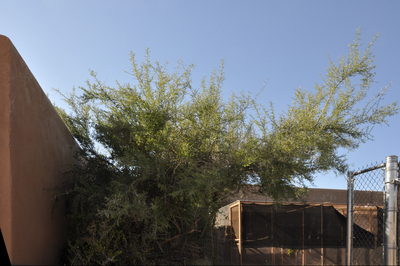

Names
Scientific Name: Zizyphus obtusifolia
Synonym: Condalia lycioides, Condalia obtusifolia, Condaliopsis lycioides, Zizyphus obtusifolia var. canescens, Zizyphus obtusifolia var. obtusifolia
Common Names: Graythorn, lotebush, gumdrop tree, chaparro prieto, abrojo
Characteristics
Duration: Perennial
Growth Habit: Shrub
Arizona Native Status: Native
Habitat: desert, grasslands, shrub-steppe. Common member of mesquite communities; also grows in association with wolfberry, fourwing saltbush, and prickly pear.
Flower Color: white (inconspicuous)
Flowering Season: late spring
Height: 8 to 12 feet
Description: A medium-sized shrub that is densely branched and leafy, Graythorn's branches are light gray with thorn-tipped branchlets. The small green leaves drop off during the summer, exposing the branches. The bloom is waxy, white and inconspicuous. It is followed by small, black berries.
Special Characteristics
Graythorn provides excellent nesting habitat for several bird species.Graythorn berries are a food source for foxes, raccoons, ringtails, and many birds including mockingbirds, northern orioles, phainopeplas, and curve-billed thrashers. Deer sometimes browse the twigs. Indigenous people have also considered the berries a supplementary food source. The roots have been used for medicines and soaps.
Classification
Order: Rosales
Family: Rhamnaceae
SOURCES:
Irish, M. 2002. Arizona Gardener's Guide. Nashville: Cool Springs Press.
Sullivan, Janet. 1993. Zizyphus obtusifolia. In: Fire Effects Information System, [Online]. U.S. Department of Agriculture, Forest Service, Rocky Mountain Research Station, Fire Sciences Laboratory (Producer). http://www.fs.fed.us./database/feis
